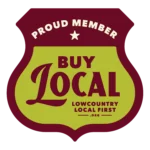This is an image of the front of a new apartment complex on James Island. Located just 3 miles from the sands of Folly, the complex’s primary selling point is its proximity to the beach. The property’s location is so important to its brand, in fact, that the complex has adopted the slogan “closest to the beach”. Its billboards depict a girl doing yoga on the beach, and the promotional signs surrounding the property are in the shape of surfboards.
Ironically, the plants decorating the entrance to the complex have nothing to do with the Lowcountry. The landscaping schema belies the complex’s “closest to the beach” brand.
Instead of using plants typically found on or near the beach like the ones used in the Lowcountry landscape design schema of the car wash down the road, the landscaper who designed the complex’s schema used plants that could be found nearly anywhere in South Carolina: loropetalums, laurels, red maples, etc. If the surfboard-shaped sign weren’t present, you could easily mistake this complex for one in the Midlands, far from the ocean.
Brick-and-mortar businesses should consider how landscape design affects their brand. Unfortunately, this apartment complex didn’t.
Seth Mason, Charleston SC








